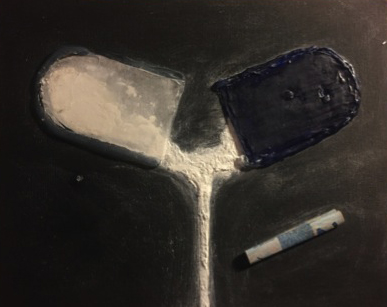Trading One Vice For The Other
This is the description used by a patient at the rehabilitation centre when he talked about previous experience in a methadone programme. This collage is comprised of two pieces of plastic that resemble a broken capsule, with a stream of white pharmaceutical substance (talcum powder) emptying from the two halves, contrasting with the painted black background. On the side, there are two rolled up Brazilian banknotes that represent that ‘Trade-Off’ from heroin addiction to sole reliance on prescribed pharmaceutical alternatives. The reason I chose textural collage as a medium is because I wanted the image to stand out starkly, to emphasize the reality of this issue. The choice of a black background was to express the dark, horrific circumstances people are in, that lead them to make these choices.
I now look back at my previous work experiences and wonder about the factors that might have led patients to come see the physicians that were in charge of me. Furthermore, if those issues were addressed would there be a more permanent solution that could improve their quality of life?
Whole Person Care, 2016

I find this piece of work representative of my own thoughts regarding drug use and the methadone program. Having only just begun my GP placements, I thought and hoped I would remain completely un-judgemental towards anyones personal position but when they came in saying they had just finished a methadone program, I thought to myself, how silly it is to get involved with drugs and why would any one would want to do it. But hearing from the patients perspective they had been asking for help for a very long time and this wasn’t taken seriously by the health system, and their troubles, anxiety and mental health led them to self medicate through use of drug use which numbed their painful thoughts. Due to the pain not being physical it remained untreated and I felt the health system had thoroughly let this patient down by not listening to their clear desperation. In order for their mental health issues to be recognised the patient swapped one drug for another, methadone. And after successful completion of that, has now swapped methadone for yet another drug, antidepressants and having a number of issues with them. As this picture represents a ‘Trade-Off’ from one addiction to another, I find the trade off of the patients overwhelming emotions to have none due to the anti depressants unfair, and the health care system needs to support the patient in finding middle ground for their life to continue without being a drug rollercoaster.
This image stood out to me after recently watching a Louis Theroux documentary about how easy it for people to get dependant on highly addictive painkillers which lead to heroine addictions. I feel the image highlights how doctors’ prescriptions can lead to further devastating problems. For example an ordinary person who started on prescription painkillers after being involved in a car accident ended up living in a tent hooked on heroin. I feel like it highlights the responsibility of the doctor to think before prescribing as the long term consequences may be life changing. Doctors should consider the joint countrywide pain formulary 2017, “First do no harm. Any treatment with medicines results in a balance of benefits or harms; if the medicine doesn’t relieve the symptoms then the result of taking the medicine is harm only” (Louis Theroux documentary referred to is Dark States: 1 Heroin town , first show on BBC2 9pm 8th October 2017)
This image highlights the link and possible pathway from prescription painkillers to recreational drugs. It’s very easy for society to pass the blame purely on to the individual who has taken the drugs, but in most cases addictions are caused by many factors, with medicine being responsible for some. This painting shows medicine being honest about its role in the rise of recreational drug use, especially opiates. After watching a recent episode of Louis Theroux in Huntington, West Virginia, it taught me about how an over-prescription of painkillers can lead to a person becoming addicted to opiates. It made me realise how big of a responsibility GP’s have when dealing with prescriptions, and the vulnerability of patients when they put their trust in their GP.
This piece of art highlighted the problems that occur surrounding addition in todays society to me. The way in which it is medicalised and attempted to be fixed while overlooking a lot of the psychological problems are overlooked. The pill being the treatment given to the patient and the overflowing of powder and the bank notes showing it isn’t that easy to fix.